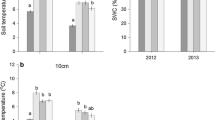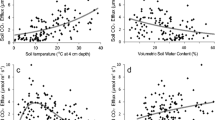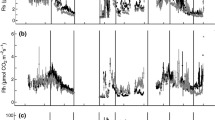Abstract
Total soil respiration (Rt) is a combination of autotrophic (Ra) and heterotrophic respiration (Rh). Root exclusion methods, such as soil trenching, are often utilized to separate these components. This method involves severing the rooting system surrounding a plot to remove the Ra component. However, soil trenching has potential limitations including (1) reduced water uptake in trenched plots that increases soil water content, which is one of the environmental controllers of Rt in many ecosystems, and (2) increased available carbon substrate for Rh caused by recently severed dead roots. We present a methodology that utilizes a bayesian modeling framework to quantify the magnitude of artifacts from a large trenching manipulation experiment. Thus methodology corrects Rh and Ra observations at daily to seasonal time scales. This study finds that the artifacts, due to recently severed roots, persist over a 2 years study period and the artifacts due to altered soil moisture had the greatest impact during drought conditions.



Similar content being viewed by others
Abbreviations
- Ra:
-
Autotrophic respiration
- Rh:
-
Heterotrophic respiration
- Rt:
-
Total soil respiration
- RSR:
-
Recently severed roots
- SMT:
-
Soil moisture and temperature
References
Abramoff RZ, Finzi AC (2016) Seasonality and partitioning of root allocation to rhizosphere soils in a midlatitude forest. Ecosphere 7(11):e01547. https://doi.org/10.1002/ecs2.1547
Balogh J, Papp M, Pinter K, Foti S, Posta K, Eugster W, Nagy Z (2016) Autotrophic component of soil respiration is repressed by drought more than the heterotrophic one in dry grasslands. Biogeosciences 13(18):5171–5182
Bond-Lamberty B, Thomson A (2010) Temperature-associated increases in the global soil respiration record. Nature 464(7288):579–582
Borken W, Savage K, Davidson EA, Trumbore SE (2006) Effects of experimental drought on soil respiration and radiocarbon efflux from a temperate forest soil. Glob Chang Biol 12(2):177–193
Cheng WX (2009) Rhizosphere priming effect: its functional relationships with microbial turnover, evapotranspiration, and C-N budgets. Soil Biol Biochem 41(9):1795–1801
Ciais P, Sabine C, Bala G, Bopp L, et al (2013) Carbon and other biogeochemical cycles. In: Stocker TF, Qin D, Plattner G-K, Tignor M, Allen SK, Boschung J, Nauels A, Xia Y, Bex V, Midgley PM (eds.) Climate change: the physical science basis. contribution of working group I to the fifth assessment report of the intergovernmental panel on climate change. Cambridge University Press, Cambridge
Cisneros-Dozal LM, Trumbore SE, Hanson PJ (2006) Partitioning sources of soil-respired CO(2) and their seasonal variation using a unique radiocarbon tracer. Glob Chang Biol 12(2):194–204
Compton JE, Boone RD (2000) Long-term impacts of agriculture on soil carbon and nitrogen in New England forests. Ecology 81(8):2314–2330
Comstedt D, Bostrom B, Ekblad A (2011) Autotrophic and heterotrophic soil respiration in a Norway spruce forest: estimating the root decomposition and soil moisture effects in a trenching experiment. Biogeochemistry 104(1–3):121–132
Davidson EA, Janssens IA, Luo YQ (2006) On the variability of respiration in terrestrial ecosystems: moving beyond Q(10). Glob Chang Biol 12(2):154–164
Davidson EA, Samanta S, Caramori SS, Savage K (2012) The Dual Arrhenius and Michaelis-Menten kinetics model for decomposition of soil organic matter at hourly to seasonal time scales. Glob Chang Biol 18(1):371–384
Diaz-Pines E, Schindlbacher A, Pfeffer M, Jandl R, Zechmeister-Boltenstern S, Rubio A (2010) Root trenching: a useful tool to estimate autotrophic soil respiration? A case study in an Austrian mountain forest. Eur J For Res 129(1):101–109
Drake JE, Oishi AC, Giasson MA, Oren R, Johnsen KH, Finzi AC (2012) Trenching reduces soil heterotrophic activity in a loblolly pine (Pinus taeda) forest exposed to elevated atmospheric [CO2] and N fertilization. Agric For Meteorol 165:43–52
Epron D, Farque L, Lucot E, Badot PM (1999) Soil CO2 efflux in a beech forest: the contribution of root respiration. Ann For Sci 56(4):289–295
Epron D, Le Dantec V, Dufrene E, Granier A (2001) Seasonal dynamics of soil carbon dioxide efflux and simulated rhizosphere respiration in a beech forest. Tree Physiol 21(2–3):145–152
Fahey TJ, Siccama TG, Driscoll CT, Likens GE, Campbell J, Johnson CE, Battles JJ, Aber JD, Cole JJ, Fisk MC, Groffman PF, Hamburg SP, Holmes RT, Schwarz PA, Yanai RD (2005) The biogeochemistry of carbon at Hubbard Brook. Biogeochemistry 75:109–176
Finzi AC, Abramoff RZ, Spiller KS, Brzostek ER, Darby BA, Kramer MA, Phillips RP (2015) Rhizosphere processes are quantitatively important components of terrestrial carbon and nutrient cycles. Glob Chang Biol 21(5):2082–2094
Gaudinski JB, Trumbore SE, Davidson EA, Zheng SH (2001) Soil carbon cycling in a temperate forest: radiocarbon-based estimates of residence times, sequestration rates and partitioning of fluxes (vol 51, pg 33, 2000). Biogeochemistry 52(1):113–114
Gaumont-Guay D, Black TA, Barr AG, Jassal RA, Nesic Z (2008) Biophysical controls on rhizospheric and heterotrophic components of soil respiration in a boreal black spruce stand. Tree Physiol 28(2):161–171
Giasson M-A, Ellison MA, Bowden RD, Crill PM, Davidson EA, Drake JE, Frey SD, Hadley JL, Lavine M, Melillo JM, Munger JW, Nadelhoffer KJ, Nicoll L, Ollinger SV, Savage KE, Steudler PA, Tang J, Varner RK, Wofsy SC, Foster DR, Finzi AC (2013) Soil respiration in a northeastern US temperate forest: a 22-year synthesis. Ecosphere 4(11):140. https://doi.org/10.1890/ES13.00183.1
Hanson PJ, Edwards NT, Garten CT, Andrews JA (2000) Separating root and soil microbial contributions to soil respiration: a review of methods and observations. Biogeochemistry 48(1):115–146
Högberg P, Nordgren A, Buchmann N, Taylor AF, Ekblad A, Hogberg MN, Nyberg G, Ottosson-Lofvenius M, Read DJ (2001) Large-scale forest girdling shows that current photosynthesis drives soil respiration. Nature 411(6839):789–792
Jarosz A, Wiley J (2014) What are the odds? A practical guide to computing and reporting Bayes factors. J Probl Solving 7(1):2
Jassal RS, Black TA, Novak MD, Gaumont-Guay D, Nesic Z (2008) Effect of soil water stress on soil respiration and its temperature sensitivity in an 18-year-old temperate Douglas-fir stand. Glob Chang Biol 14(6):1305–1318
Lavigne MB, Boutin R, Foster RJ, Goodine G, Bernie PY, Robitaille G (2003) Soil respiration responses to temperature are controlled more by roots than by decomposition in balsam fir ecosystems. Can J For Res 33(9):1744–1753
Matamala R, Gonzalez-Meler MA, Jastrow JD, Norby RJ, Schlesinger WH (2003) Impacts of fine root turnover on forest NPP and soil C sequestration potential. Science 302(5649):1385–1387
McClaugherty CA, Aber JD, Melillo JM (1984) Decomposition dynamics of fine roots in forested ecosystems. Oikos 42(3):378–386
Orwig DA, Plotkin AAB, Davidson EA, Lux H, Savage KE, Ellison AM (2013) Foundation species loss affects vegetation structure more than ecosystem function in a northeastern USA forest. PeerJ 1:e41. https://doi.org/10.7717/peerj.41
Phillips RP, Erlitz Y, Bier R, Bernhardt ES (2008) New approach for capturing soluble root exudates in forest soils. Funct Ecol 22(6):990–999. https://doi.org/10.1111/j.1365-2435.2008.01495.x
Phillips RP, Finzi AC, Bernhardt ES (2011) Enhanced root exudation induces microbial feedbacks to N cycling in a pine forest under long-term CO2 fumigation. Ecol Lett 14(2):187–194. https://doi.org/10.1111/j.1461-0248.2010.01570.x
Savage KE, Davidson EA (2001) Interannual variation of soil respiration in two New England forests. Global Biogeochem Cycles 15(2):337–350
Savage K, Davidson EA, Richardson AD, Hollinger DY (2009) Three scales of temporal resolution from automated soil respiration measurements. Agric For Meteorol 149(11):2012–2021
Savage K, Davidson EA, Tang J (2013) Diel patterns of autotrophic and heterotrophic respiration among phenological stages. Glob Chang Biol 19(4):1151–1159
Savage K, Phillips R, Davidson E (2014) High temporal frequency measurements of greenhouse gas emissions from soils. Biogeosciences 11(10):2709–2720
Schulze ED, Ciais P, Luyssaert S, Schrumpf M, Janssens IA, Thiruchittampalam B, Theloke J, Saurat M, Bringezu S, Lelieveld J, Lohila A, Rebmann C, Jung M, Bastviken D, Abril G, Grassi G, Leip A, Freibauer A, Kutsch W, Don A, Nieschulze J, Börner A, Gash JH, Dolman AJ (2010) The European carbon balance. Part 4: integration of carbon and other trace-gas fluxes. Glob Chang Biol 16:1451–1469
Scott-Denton LE, Rosenstiel TN, Monson RK (2006) Differential controls by climate and substrate over the heterotrophic and rhizospheric components of soil respiration. Glob Chang Biol 12(2):205–216
Subke JA, Inglima I, Cotrufo MF (2006) Trends and methodological impacts in soil CO2 efflux partitioning: a metaanalytical review. Glob Chang Biol 12(6):921–943
Tang JW, Misson L, Gershenson A, Cheng WX, Goldstein AH (2005) Continuous measurements of soil respiration with and without roots in a ponderosa pine plantation in the Sierra Nevada Mountains. Agric For Meteorol 132(3–4):212–227
Acknowledgements
This work was funded by the DOE- TES, Award Number DE-SC0006741. All model code in Supplementary Materials S1 and S2 are made available in the GitHub repository https://github.com/Savage149/Trenching-Artifacts.
Author information
Authors and Affiliations
Corresponding author
Additional information
Responsible Editor: Sasha C. Reed.
Electronic supplementary material
Below is the link to the electronic supplementary material.
10533_2018_472_MOESM1_ESM.zip
S1: two files with the R code (S1_decomp_model_FINAL.R) and jags model code (S1_rootdecomp_jags_FINAL.R) for the bayesian modeling for recently severed roots (RSR) plus a sample data file (S1_rootdecomp.csv). Supplementary material 1 (ZIP 3 kb)
10533_2018_472_MOESM2_ESM.zip
S2_SMT: two files with the R code (S2_Q10andWC_model_FINAL.R) and jags model code (S2_Q10andWC_jags_FINLA.R) for the bayesian modeling for moisture and temperature artifacts plus a sample data file (S2_Fluxdata_example.csv). Supplementary material 2 (ZIP 13 kb)
Rights and permissions
About this article
Cite this article
Savage, K.E., Davidson, E.A., Abramoff, R.Z. et al. Partitioning soil respiration: quantifying the artifacts of the trenching method. Biogeochemistry 140, 53–63 (2018). https://doi.org/10.1007/s10533-018-0472-8
Received:
Accepted:
Published:
Issue Date:
DOI: https://doi.org/10.1007/s10533-018-0472-8




